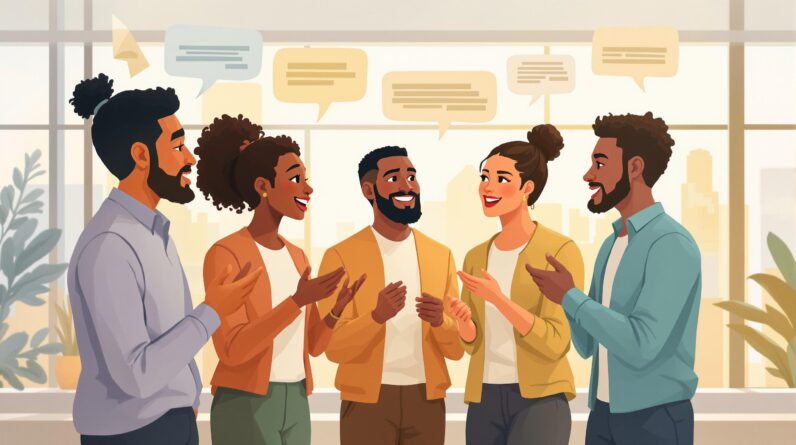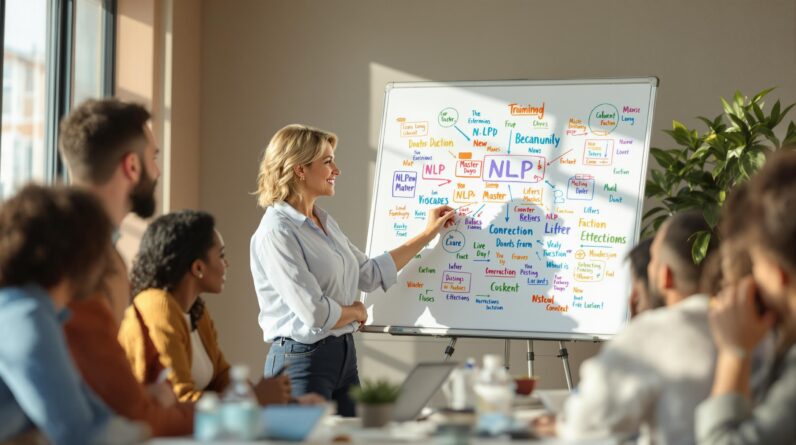
Neuro-Linguistic Programming (NLP) is a practical method for understanding and improving how you think, communicate, and behave. It connects your thoughts (neuro), language (linguistic), and actions (programming) to help you create positive changes in your life. Here’s what you’ll learn in this guide:
- Core Principles: Understand concepts like "The Map is Not the Territory" (everyone sees the world differently) and how every behavior has a positive intention.
- Beginner Techniques:
- Visualization: Imagine success to prepare for challenges.
- Swish Technique: Replace negative thoughts with positive ones.
- Modeling Success: Learn from successful people’s habits and strategies.
- Mirroring: Build rapport by aligning body language and tone.
- Applications: Use NLP for personal growth, improving communication, and workplace success.
NLP emphasizes actionable tools for better communication, self-growth, and achieving goals. Start small, practice consistently, and explore resources like beginner-friendly books or free guides to deepen your understanding.
NLP Techniques for Beginners
Visualization Techniques
Visualization involves using mental imagery to prepare for success. For example, before a job interview, take 5-10 minutes daily to picture yourself confidently answering questions and leaving a strong impression. Engage all your senses – imagine the sights, sounds, emotions, and even physical sensations of the situation.
The Swish Technique
The Swish Technique helps replace negative thoughts with positive ones by creating a mental "switch" between what you don’t want and your desired outcome.
Here’s how it works:
| Step | Action | Purpose |
|---|---|---|
| 1. Identify | Pinpoint the negative thought or behavior | Build self-awareness |
| 2. Visualize | Picture your ideal state clearly | Focus on your goal |
| 3. Swish | Rapidly replace the negative image with the positive one | Create new mental links |
| 4. Repeat | Practice the process multiple times | Strengthen the new pattern |
Modeling Success
This method involves analyzing and adopting the habits, thought processes, and strategies of successful people. It’s not just about copying actions – it’s about understanding the deeper elements that lead to their achievements.
Focus on these key areas:
- Mindset: Learn their beliefs and how they approach challenges.
- Strategy: Examine their decision-making and planning methods.
- Action: Observe the specific behaviors that contribute to their success.
Mirroring for Communication
Mirroring is a technique where you subtly align with someone’s body language, tone, and speaking pace to create a sense of connection. This can help build rapport in both personal and professional interactions.
Key elements to mirror include:
- Body language
- Speech patterns
- Tone of voice
- Speaking rhythm
Practice this skill carefully to make interactions more natural and engaging.
These techniques provide a strong starting point for using NLP in everyday life. Let’s move on to explore how NLP can enhance various aspects of your personal and professional growth.
Applications of NLP
Personal Growth
NLP provides tools that can help you grow and improve yourself. By practicing its techniques, you can boost your self-awareness, sharpen emotional intelligence, and adopt a mindset focused on growth. These methods help shift limiting beliefs into empowering ones, paving the way for positive changes in how you handle challenges and opportunities.
Improving Communication
NLP reshapes how you communicate by emphasizing both what you say and how you say it. It takes into account body language, tone, and subtle behaviors that often speak louder than words.
"We can change the way we think, feel and behave by changing our focus – because where focus goes, energy flows." – Tony Robbins [2]
This idea reflects NLP’s focus on intentionally directing attention and energy toward achieving desired results, especially in communication.
Here are some NLP strategies to strengthen your communication:
- Active Listening: Pay close attention to words, tone, and body language.
- Rapport Building: Foster genuine connections through thoughtful interactions.
- Understanding Perspectives: Adapt to different communication styles to connect better.
By improving how you express yourself and understand others, NLP not only enhances your communication skills but also boosts self-confidence and emotional awareness.
NLP in the Workplace
NLP techniques are just as effective in professional settings, helping leaders and teams communicate better, understand motivations, and resolve conflicts. These tools can strengthen leadership and teamwork, leading to better results.
Here’s how NLP can be applied at work:
- Use visualization to prepare for presentations, boosting confidence and anticipating obstacles.
- Study and emulate the communication and decision-making styles of successful leaders.
- Adjust your communication approach based on the audience or situation to connect more effectively.
Adapting your communication style to different scenarios is key to building strong relationships with colleagues, teams, and stakeholders in the workplace. This flexibility can be a game-changer in professional success.
sbb-itb-d87b7ee
Starting with NLP
Recommended Resources
Dive into foundational books like The Structure of Magic by Bandler and Grinder to understand core NLP principles, or NLP: The New Science of Achievement by Bavister and Vickers for actionable strategies. If you prefer a structured approach, the Achology NLP Practitioner Certification offers beginner-friendly lessons with hands-on exercises to grasp essential concepts.
NLP Yourself: A Learning Platform

NLP Yourself provides beginner-friendly resources, including free guides and practical tools to apply NLP in personal and professional settings. It’s a great place to start exploring NLP concepts without any upfront cost, making it easier to decide if you want to dive into paid courses later.
Practicing NLP Techniques
To get the most out of NLP, consistent and focused practice is essential. Once you’ve built a solid understanding, focus on applying techniques in your everyday life:
- Use daily visualization to clarify goals and maintain focus.
- Improve communication by mirroring others’ body language, tone, and speech patterns to create rapport.
- Keep a journal to track your progress and consider joining NLP practice groups for feedback and encouragement.
"The key to mastering NLP lies not in understanding its concepts but in consistent daily practice and application in real-world situations", says Sam Visnic, founder of NLP Yourself [1].
Neuro Linguistic Programming Techniques You Can Use Instantly
Conclusion and Takeaways
Neuro-Linguistic Programming (NLP) provides tools to better understand and influence behavior, offering opportunities for growth in both personal and professional areas.
As Dr. Richard Bandler, co-creator of NLP, explains:
"NLP is a model of how people structure their experience; it’s about how to change the way you think and feel" [2].
To get started with NLP, focus on small, everyday applications. Pick one or two techniques and practice them consistently. The key to progress is regular use, not just reading about the concepts. For more structured learning, consider resources like the Achology NLP Certification or free tools from NLP Yourself.
NLP emphasizes solutions and actionable steps, helping you create positive changes in areas like communication, career development, or personal growth. It offers practical methods to turn goals into achievable outcomes.
Related posts
- 5 NLP Exercises to Boost Workplace Productivity
- Common NLP Practice Mistakes and How to Avoid Them
- Top 8 NLP Books for Personal Development
- Step-by-Step Guide to NLP Self-Training Success







